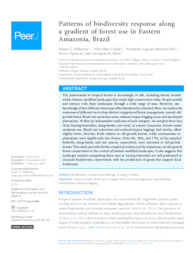Patterns of biodiversity response along a gradient of forest use in Eastern Amazonia, Brazil.
Patterns of biodiversity response along a gradient of forest use in Eastern Amazonia, Brazil.
Author(s): MILHEIRAS, S. G.; GUEDES, M. C.; SILVA, F. A. B.; APARÍCIO, P.; MACE, G. M.
Summary: The preservation of tropical forests is increasingly at risk, including forests located within human-modified landscapes that retain high conservation value. People modify and interact with these landscapes through a wide range of uses. However, our knowledge of how different forest uses affect biodiversity is limited. Here, we analyse the responses of different taxa to four distinct categories of forest management, namely oldgrowth forest, Brazil nut extraction areas, reduced impact logging areas, and eucalyptus plantations. Within six independent replicates of each category, we sampled three taxa (fruit-feeding butterflies, dung beetles, and trees) in eastern Amazonia. Forests under moderate use (Brazil nut extraction and reduced-impact logging) had similar, albeit slightly lower, diversity levels relative to old-growth forests, while communities in plantations were significantly less diverse. Only 4%, 20%, and 17%, of the sampled butterfly, dung beetle, and tree species, respectively, were restricted to old-growth forests. This study provides further empirical evidence of the importance of old-growth forest conservation in the context of human-modified landscapes. It also suggests that landscape matrices integrating forest uses at varying intensities are well positioned to reconcile biodiversity conservation with the production of goods that support local livelihoods.
Publication year: 2020
Types of publication: Journal article
Unit: Embrapa Amapá
Observation
Some of Embrapa's publications are published as ePub files. To read them, use or download one of the following free software options to your computer or mobile device. Android: Google Play Books; IOS: iBooks; Windows and Linux: Calibre.
Access other publications
Access the Agricultural Research Database (BDPA) to consult Embrapa's full library collection and records.
Visit Embrapa Bookstore to purchase books and other publications sold by Embrapa.

